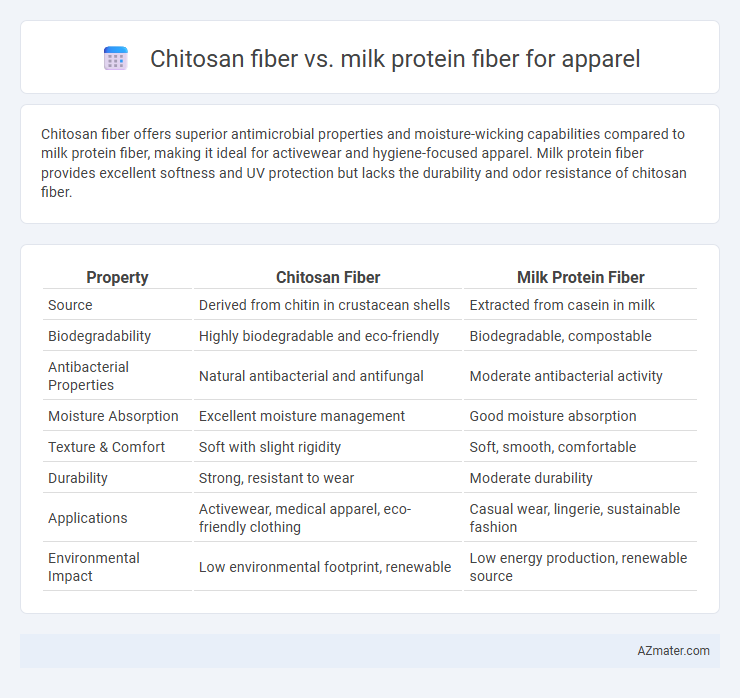Chitosan fiber offers superior antimicrobial properties and moisture-wicking capabilities compared to milk protein fiber, making it ideal for activewear and hygiene-focused apparel. Milk protein fiber provides excellent softness and UV protection but lacks the durability and odor resistance of chitosan fiber.
Table of Comparison
| Property | Chitosan Fiber | Milk Protein Fiber |
|---|---|---|
| Source | Derived from chitin in crustacean shells | Extracted from casein in milk |
| Biodegradability | Highly biodegradable and eco-friendly | Biodegradable, compostable |
| Antibacterial Properties | Natural antibacterial and antifungal | Moderate antibacterial activity |
| Moisture Absorption | Excellent moisture management | Good moisture absorption |
| Texture & Comfort | Soft with slight rigidity | Soft, smooth, comfortable |
| Durability | Strong, resistant to wear | Moderate durability |
| Applications | Activewear, medical apparel, eco-friendly clothing | Casual wear, lingerie, sustainable fashion |
| Environmental Impact | Low environmental footprint, renewable | Low energy production, renewable source |
Introduction to Chitosan and Milk Protein Fibers
Chitosan fiber, derived from the deacetylation of chitin found in crustacean shells, exhibits remarkable antimicrobial properties and biodegradability, making it a sustainable choice for eco-friendly apparel. Milk protein fiber, produced by regenerating casein protein from milk, offers exceptional softness, moisture absorption, and skin-friendly benefits, ideal for sensitive skin garments. Both fibers present innovative natural alternatives to synthetic textiles, contributing to functional and sustainable fashion solutions.
Fiber Origin and Extraction Processes
Chitosan fiber is derived from chitin, primarily sourced from crustacean shells such as shrimp and crab, undergoing deacetylation to convert chitin into chitosan, then spun into fibers through wet spinning processes. Milk protein fiber, also known as casein fiber, is extracted from milk proteins by precipitating casein using acid or enzymes, followed by dissolving and wet spinning to form fine, soft fibers suitable for apparel. Both fibers leverage natural biopolymers but differ significantly in their raw material origin--marine crustacean waste versus dairy--and extraction techniques, impacting their biodegradability and moisture management properties in textiles.
Physical Properties Comparison
Chitosan fiber exhibits superior moisture absorption and antibacterial properties compared to milk protein fiber, making it ideal for activewear and sensitive skin applications. Milk protein fiber, while offering excellent softness and elasticity, tends to have lower tensile strength and durability than chitosan fiber, impacting long-term garment performance. Both fibers provide biodegradability, but chitosan's enhanced mechanical resistance and odor control capabilities make it preferable for high-performance apparel.
Comfort and Wearability in Apparel
Chitosan fiber offers excellent moisture absorption and antibacterial properties, enhancing comfort and hygiene for apparel wearers. Milk protein fiber provides superior softness and breathability, contributing to a lightweight and comfortable garment feel. Both fibers improve wearability, but chitosan fiber excels in odor control while milk protein fiber emphasizes skin-friendly softness.
Moisture Management and Breathability
Chitosan fiber offers superior moisture management due to its natural hygroscopic properties, effectively absorbing and releasing moisture to keep the skin dry and comfortable. Milk protein fiber enhances breathability with its smooth texture and moisture-regulating capabilities, promoting air circulation and reducing sweat retention. Both fibers provide excellent moisture control, but chitosan fiber excels in antimicrobial benefits, while milk protein fiber stands out for its softness and biodegradability in apparel applications.
Antibacterial and Hypoallergenic Qualities
Chitosan fiber exhibits strong antibacterial properties due to its natural ability to inhibit bacterial growth, making it highly effective in preventing odor and infections in apparel. Milk protein fiber, rich in proteins like casein, offers excellent hypoallergenic qualities by soothing sensitive skin and reducing irritation. Both fibers support comfort and hygiene, but chitosan's superior antimicrobial action gives it a distinct advantage in antibacterial apparel applications.
Dyeing and Color Fastness
Chitosan fiber exhibits superior dye affinity due to its amino groups, which allow for better dye uptake and deeper, more vibrant colors compared to milk protein fiber. Milk protein fiber, while soft and breathable, often struggles with uniform dye penetration, resulting in lighter shades and lower color fastness. Chitosan fiber also demonstrates enhanced color fastness to washing and light, making it more suitable for apparel requiring durable and long-lasting coloration.
Sustainability and Environmental Impact
Chitosan fiber, derived from crustacean shells, offers biodegradability and natural antibacterial properties, making it a sustainable choice with minimal environmental footprint in apparel production. Milk protein fiber, produced from casein extracted from dairy byproducts, is biodegradable and renewable but may have higher environmental costs due to water and energy usage in processing. Both fibers support eco-friendly fashion, though chitosan's use of waste materials and inherent antimicrobial benefits provide a stronger edge in reducing ecological impact and enhancing garment longevity.
Cost and Market Availability
Chitosan fiber, derived from crustacean shells, generally costs more due to complex extraction processes compared to milk protein fiber, which utilizes casein protein from abundant dairy byproducts. Market availability favors milk protein fiber as it benefits from established dairy industry supply chains, while chitosan fiber remains niche with limited large-scale production. Apparel manufacturers often prefer milk protein fiber for cost-effectiveness and consistent supply, despite chitosan fiber offering unique antimicrobial properties.
Future Prospects in Textile Innovation
Chitosan fiber exhibits strong antimicrobial properties and biodegradability, making it a sustainable choice for future apparel innovation. Milk protein fiber offers excellent moisture absorption and soft texture, ideal for comfort-focused clothing. Advances in biotechnology are expected to enhance the performance and scalability of both fibers, driving their adoption in eco-friendly and functional textiles.

Infographic: Chitosan fiber vs Milk protein fiber for Apparel
 azmater.com
azmater.com